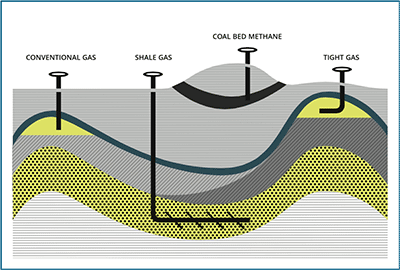Shallow gas operational FAQs
What is the difference between "conventional" and "unconventional" natural gas production?
The term “unconventional gas” refers to three main types of natural gas: shallow gas from coal seams, shale gas and tight gas. Conventional and unconventional gases differ, not so much by their chemical compositions, but by the geological characteristics of their reservoir rock.
Most shallow gas from coal seams is stored (adsorbed) within the molecular structure of the coal and is held in place by the pressure of the overlying rock. Decline rates are low with reserve life in the 25 to 30 year range. In contrast, conventional gas is often found trapped within spaces found naturally within the rock formation itself. Conventional gas production tends to have large initial production rates which decline very quickly with reserve life of less than a decade.
Most of the large reserves of conventional natural gas in North America have been found and are in a stage of declining production. Unconventional gas is seen as playing an important role in reducing the gap between future demands and declining conventional production.
Why focus on shallow gas production?
Unconventional gas resources such as shallow gas from coal seams is becoming increasingly important. Canada’s conventional natural gas production peaked in 2000 with Western Canada’s conventional gas pools maturing and accelerating in their decline.
The Alberta Geological Survey estimates there may be up to 179 trillion cubic feet of natural gas in Alberta’s Horseshoe Canyon coals. Unconventional gas resources like shallow gas from coal seams will fill current and future generations’ energy needs.
What are some of the advantages of shallow gas as a source of natural gas?
Shallow gas from coal seams is a low-cost, long-life natural gas resource. It has the advantage of being a self-sourcing reservoir where most of the gas is absorbed on the surface of the coal where the reservoir itself acts as an excellent “storage medium”.
Shallow gas in coal seams migrates through naturally occurring fractures in the coal called cleats, flowing to our wellbores and then to the surface under low pressure. Unlike most shallow gas resources which use powerful fracking techniques, shallow gas wells require a nitrogen stimulation, which means no water, chemicals or proppants.
Conventional shale and tight sand gas wells start out with high production rates, but decline rapidly over a period of about 6 to 10 years. Comparatively, Ember’s shallow gas wells have a much shallower decline rate. Wells reach peak production soon after drilling and decline modestly in the early years, with lower declines in later life with well typically producing for 25-30 years.
Is shallow gas competitive with shale gas plays?
While new technologies are unlocking significant new gas supplies from shale gas resource plays, our shallow gas assets in Alberta can compete with unconventional gas plays across North America. To ensure success in the current business environment, we have cost structures competitive with these new sources of supply.

